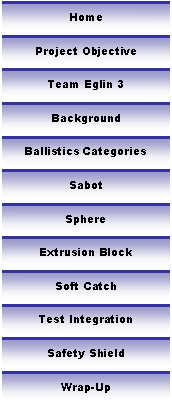
|
Sabot-Design Generation/Selection |
|
Keeping the scope of the component in mind, the team brainstormed ideas for the sabot. All the following designs are detailed in their respective section below.
Sabot Decision Matrix This decision matrix, similar to the first one, used four weighted categories.
Ease of use : This category deals with how easy the sabot would be to load into the muzzle. This includes the ease of getting the sphere into the sabot, the ability of the sabot to stay in position before the test, and its ability to cradle the projectile. The weight of 10% was chosen because the ease of setting up was important but much less important than the other attributes.
Machinability: Machinability is determined from the ease of fabrication. This includes the difficulty of the cuts required. The material, however, is already determined and has no effect of this category. A weight of 30% was chosen because this part is to be made in large quantity for multiple tests so ease of fabrication is very important.
Effectiveness: The category deals with the ability of the sabot to perform its function. This includes creating a gas seal with the muzzle and the ability to pull away mid-flight or to be deflected before the projectile hits the extrusion block. This is the most important of all criteria because it will directly impact the test if it fails to perform.
Weight: This category deals with the overall weight of the sabot. Since the material is predetermined, this only includes the volume of the sabot. This category was given a 20% weight because the size and weight of the sabot affects how well it functions.
Each category is rated from 0 to 1, 0 being the worst and 1 being the best. Each cell is multiplied by its weight then added to the rest of the values of that row. The maximum total is equal to 1.
Conclusion The third sabot design was selected from the decision matrix . Research showed the design is very similar to those already used at Eglin for the Taylor test. The design that was chosen has the best control over the specimen which, according to research is the most important aspect of the design. The design also is the easiest to machine. It is desired that the sabot pull away from the projectile or deflect off the block. In either case the sabot is very likely to deform so the tests require many sabots to be machined.
|




|
Copyright 2006-2007 Famu-Fsu College of Engineering . All Rights Reserved |
|
Design |
Set-up ability-10% |
Machinability-30% |
Effectiveness-40% |
Weight-20% |
Total |
|
1 |
.4 |
.6 |
.4 |
.6 |
.5 |
|
2 |
.8 |
.1 |
.6 |
.8 |
.51 |
|
3 |
.8 |
.8 |
.8 |
.4 |
.72 |